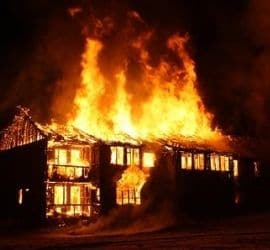What Is Hazard Insurance?
 Hazard insurance is insurance coverage that protects a property owner against damage caused by fires, severe storms, or other natural events. As long as the specific weather event is listed within the policy, the property owner will receive compensation to cover the cost of damage incurred. Typically, the property owner will be required to pay for a year’s worth of premiums at the time of purchasing the policy. Of course, this practice will depend on the exact details of the policy.
Hazard insurance is insurance coverage that protects a property owner against damage caused by fires, severe storms, or other natural events. As long as the specific weather event is listed within the policy, the property owner will receive compensation to cover the cost of damage incurred. Typically, the property owner will be required to pay for a year’s worth of premiums at the time of purchasing the policy. Of course, this practice will depend on the exact details of the policy.
- Hazard insurance protects a property owner against structural damage caused by fires, severe storms, and other natural events.
- Hazard coverage usually refers to a section of a general homeowner’s insurance policy that protects the structure of the home.
- Mortgage lenders often require you to have a homeowner’s insurance policy to get hazard coverage.
- In areas prone to certain risks, such as floods or landslides, homeowners often opt to take out separate or additional catastrophe coverage to cover specific contingencies.
How Hazard Insurance Works
Hazard coverage protects a property owner against damage caused by natural events. This usually includes damage by fires, lightning, hail, wind, snow, or rainstorms. This coverage is often a subsection of a homeowner’s insurance policy. It protects the main dwelling and other nearby structures, such as a garage. Homeowners should be sure that specific, common hazards are covered in their insurance policy package. The amount of coverage required depends on what it would cost to replace the home in the event of a total loss. This dollar amount may differ significantly from the property’s value to the current real estate market. Policies are typically written for one year and are renewable.
Hazard Coverage and Mortgages
If you take out a mortgage on your home, it’s common for your lender to require you to carry homeowners insurance. Typically, most lenders are most interested in hazard coverage. That is the portion of the homeowner’s insurance directly related to the home structure itself. Much of the remainder of the policy pertains to personal liability, loss-of-use, or personal property coverage. Usually, purchasing a general homeowner’s policy will satisfy the lender’s requirement. However, the level of protection required will depend on the laws of the local municipality, and other special considerations. If you have a very expensive property in a high-risk area, the lender may require additional coverage.
Separate Catastrophe Insurance Policies
In some areas, certain natural or weather-related events are excluded from a homeowner’s insurance. This is usually because the area is prone to these events. As a result, it’s too costly for the insurance issuer to include them in a standard policy. For example, a Florida beachfront property can be susceptible to hurricanes and tropical storms. California properties located close to fault lines face earthquakes threats.
If homeowners live in a high-risk area, they often need separate catastrophe insurance coverage to adequately protect their property. This might include a flood insurance policy or coverage that protects against sinkholes and landslides. These events are rarely covered by conventional homeowner’s insurance’s hazard coverage.
How much Hazard Insurance Coverage do you need?
How much will it cost to replace your home if it’s totally lost to a disaster? That’s how much hazard coverage you need. That dollar amount should take into account the cost of your home, the value on the current market, and the cost to replace the contents of your home.
What to look for when shopping for hazard insurance
Hazard insurance is part of your homeowner’s policy, so you’ll want to make sure your homeowners policy is as comprehensive as possible. Not all policies are equal, though. The easiest way to handle it is to ask yourself what you need covered and then make sure any plan you consider includes it. If you live in an area that’s prone to earthquakes, mudslides, or landslides, or you’re in a floodplain, you may have to purchase supplemental coverage on top of regular hazard coverage. Earthquake insurance and flood insurance are both sold through most private insurance providers.
Cost of Hazard Insurance
Hazard insurance costs also vary depending on the area in which you live. This is because some regions are more likely to experience certain types of extreme weather and natural disasters. Hazard insurance usually applies to disasters where the structure of your home is damaged. It does not usually cover personal items inside the home.
Premiums
A premium is a regular payment required to maintain insurance coverage. The premium is set at the beginning of the insurance contract, but the carrier will reserve the right to raise it in the future. The amount of the premium depends on the value of your home and includes a calculation of the risk of damage in the area where you live. Insurance premiums may be paid monthly, quarterly, semiannually, or annually.
Hazard insurance makes up just one portion of your homeowner’s insurance policy. You can expect to pay between .25% and .33% of your home’s purchase price for hazard insurance over a twelve-month period. Higher-end policies cover open perils (a broad range of perils except those explicitly excluded by the policy), while less expensive policies may be limited to 10 to 16 named perils. Hazard insurance applies to instances where the structure of your home is damaged, rather than covering personal items inside the home. Hazard insurance helps cover the costs of repairing or rebuilding the structure of your home. To protect what you keep inside it, you’ll need to turn to the personal property coverage portion of your home insurance. (Sourcr: thesimpledollar.com)
Frequently Asked Questions
What is homeowner’s insurance?
Homeowners insurance, in its most basic form, is coverage for your home, personal property, and combined assets in the event your property is damaged, burglarized, or you’re held liable for an accident.
Is hazard insurance the same as homeowner’s insurance?
In order to get a mortgage loan for your new home, you need to have a certain amount of hazard coverage included in your homeowner’s insurance coverage. Hazard coverage is part of a homeowner’s insurance policy – it is not a separate coverage type. It is essential to keeping you, your family, and your house safe.
Who should get hazard insurance?
Everyone who has a homeowner’s insurance policy automatically has hazard coverage. But this type of coverage is more valuable to homeowners in certain locations. Specifically, homeowners in states that face a high risk of natural disasters are more likely to file a hazard insurance claim.
What doesn’t hazard insurance cover?
Hazard insurance typically doesn’t cover damage from flooding or earthquakes. You will usually need to purchase a separate flood or earthquake insurance policy to cover your home.
Up Next: How Many Work Hours in a Year? How to Calculate (2020)
Are you trying to determine how many work hours in a year? Maybe you want to convert an hourly employee to a salary. Or, calculate a salaried employee’s hourly rate for partial payment? The number of working hours and wages vary from country to country. The formula to determine working hours in a year is straightforward. However, it is not as simple as adding up how many hours an employee works each week. You also need to account for how many vacation days and holidays the employee receives in a year.



